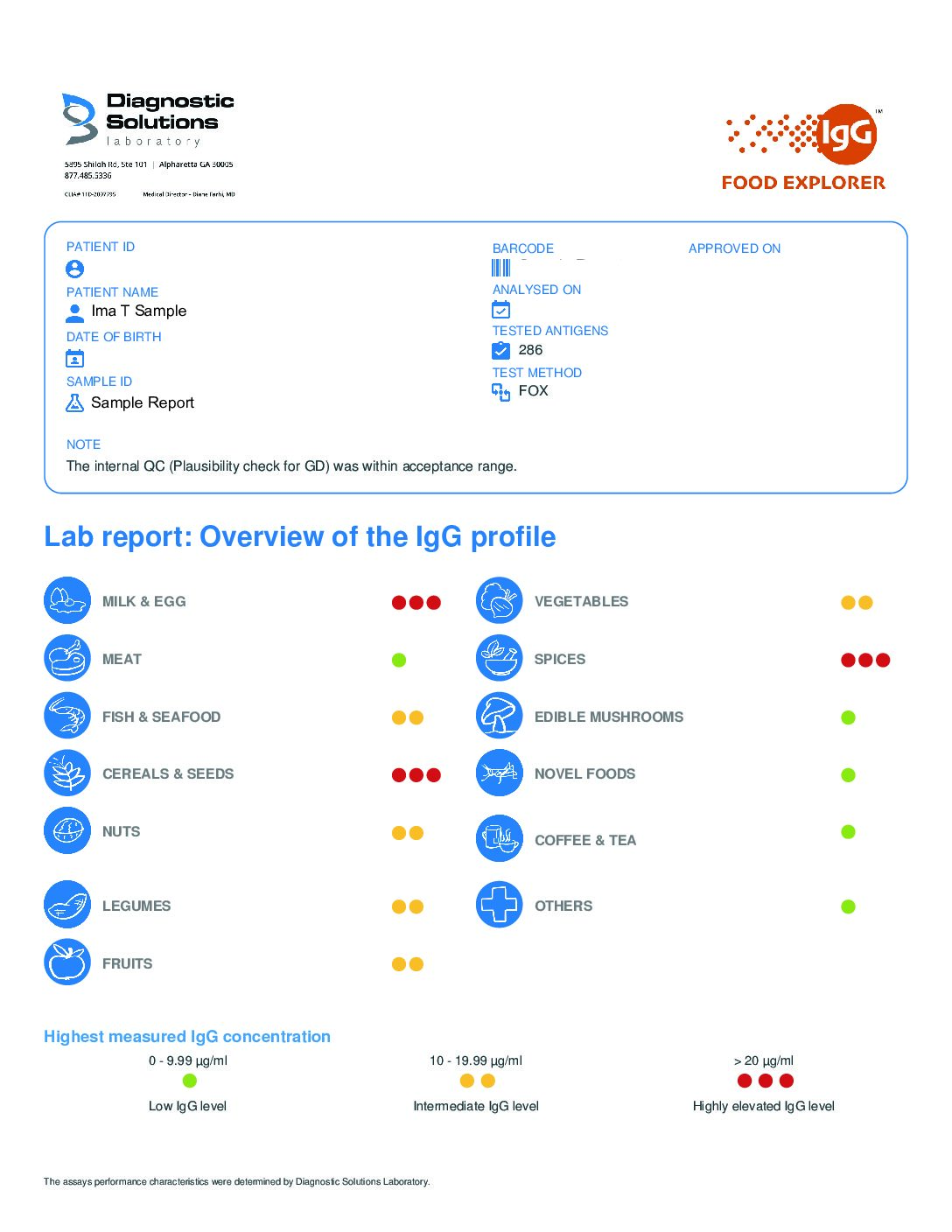Description
WHAT IS IGG?
IgG is the major antibody found in serum. IgGs are composed of two fragment antigen binding (Fab) regions that contain the antigen binding sites and the Fc region, which is responsible for most of the biologic activity of the antibodies (Figure 1). An antigen is a substance that causes the immune system to produce an antibody that specifically reacts with it. IgG-mediated reactions to food antigens may be delayed by several hours or days, whereas IgE food antibody reactions are quite immediate.
Human IgG is separated into four subclasses denoted IgG1, IgG2, IgG3, and IgG4. Each subclass varies in abundance and biological function. IgG1 and IgG3 are predominantly responsible for antibody protection against reinfection. IgG2 antibodies are opsonic (marking a pathogen for ingestion and destruction) and develop in response to carbohydrate polysaccharide antigens. IgG4 molecules function as skin-sensitizing immunoglobulins and are thought to block antibodies produced in response to chronic exposure to antigens.
WHY TEST IGG SENSITIVITIES?
Immunoglobulin G (IgG) food testing is a useful guide for structuring elimination diets for patients with many chronic conditions. Individuals with neurological, gastrointestinal, movement, and behavioral disorders often suffer from IgG food sensitivities. People may continue to eat offending foods unaware of their potential adverse effects. Symptoms associated with food sensitivities may occur hours or days after the offending food was eaten because IgG food antibodies remain for a much longer time than IgE antibodies. IgE food allergy causes the release of histamine, producing an immediate hypersensitivity reaction. In contrast, IgG food sensitivity is triggered by the binding of compliment to IgG food antigen complexes, causing an inflammatory response. This is a delayed hypersensitivity reaction in which symptoms appear anywhere from hours to days after eating the offending food. Elimination of IgG-positive foods may improve symptoms of irritable bowel syndrome, autism, AD(H)D, cystic fibrosis, rheumatoid arthritis, and epilepsy, according to numerous clinical studies.
CLINICAL SIGNIFICANCE OF IGG TESTING

The clinical significance of IgG food testing was illustrated in an early article published by an otolaryngologist who reported that the majority of his patients had substantial health improvements after eliminating foods found positive by IgG food allergy testing. The study demonstrated a 71% success rate for all symptoms, achieving at least a 75% relief. Of particular interest was the group of patients with chronic, disabling symptoms, unresponsive to other intensive treatments. Symptoms most commonly improved (75%-100%) on the elimination diets included asthma, coughing, ringing in the ears, chronic fatigue, headaches, gas, bloating, diarrhea, skin rash and itching, and nasal congestion. The most common IgG food allergies were to cow’s milk, garlic, mustard, egg yolk, tea, and chocolate. A recent study reported that 93% of non-celiac, gluten-sensitive patients showed anti-gliadin IgG antibody disappearance after a six-month adherence to a gluten-free diet. The IgG disappearance was closely related to a significant improvement of both gastrointestinal and extra-intestinal symptoms. High IgG antibody levels have frequently been found in children with diabetes mellitus, Crohn’s disease, celiac disease, and in those considered to be obese. IgG food test results are often used to develop food antibody-guided exclusion/ elimination diets. The implementation of such diets has been shown to alleviate symptoms associated with nonceliac gluten sensitivity and food sensitivity-induced atopic conditions, reduce the frequency of migraine headaches, decrease the occurrence of diarrhea, decrease failure–to-thrive among children with cystic fibrosis, reduce symptoms of irritable bowel syndrome, improve rectal compliance, decrease stool frequency in Crohn’s disease, prevent seizures and hyperkinetic behavior in children with epilepsy, and ameliorate kidney function in glomerulonephritis. Food elimination diets also hold promise for the improvement of behaviors associated with attention-deficit hyperactivity disorder.
SIGNIFICANCE OF TOTAL IGG VERSUS IGG4
The goal of IgG-mediated food allergy testing is to identify foods that are capable of triggering many adverse reactions. IgG1, IgG2, and IgG3 are all capable of causing inflammation. IgG1, IgG2, and IgG3 antibodies to food antigens form large immune complexes or lattices that activate complement proteins and increase inflammation. IgG4 antibodies to food antigens will not usually trigger inflammation because IgG4 antibodies do not bind complement. However high levels of these antibodies indicate the presence of immune reactions against food antigens. Similarly IgA antibodies are not as clinically significant due to their inability to bind complement and trigger inflammation.

THE BENEFITS OF TESTING
-
IgG testing determines if food reactions are contributing to physical or mental symptoms, and much more quickly than eliminating and then reintroducing each suspect food one-by-one over a period of time.
-
Removal of highly reactive foods from the diet is a non-invasive therapy that often mitigates a patient’s symptoms.
-
Research and clinical studies suggest food allergies identified by IgG testing can be major contributing factors to many chronic health conditions.
-
Eliminating all identified IgG-positive foods after testing can reduce stress on the immune system, decrease inflammation (helping to heal “leaky gut”), resolve food cravings, and reduce the potential for eating disorders.


